Travels with
Lois and Jason
India and Maldives
December 16, 2008 - January 12, 2009
City Highlights
Introduction
and
recurring themes
Hotels, special events
The Maldives
While many themes re-appeared
throughout our travels in the north, west and south of India, each
of the seven cities we visited had something unique for us to
see. In each city, we visited some of the major tourist sites,
and in every case, we saw very few westerners. From what we
could tell from the clothes that people wore, the overwhelming
number of visitors everywhere we went were Indians.
Delhi
Our tour focused on Old Delhi, taking us to the
location of Mahatma Gandhi’s assassination, which is now a museum,
and his cremation site, which is now a memorial with an eternal
flame. We were so glad we saw the movie Gandhi just before
going on the trip. We were told that it is a fairly accurate
depiction of Gandhi’s life, and prepared us well for our
visit.
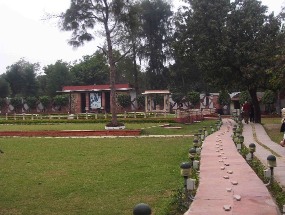
|
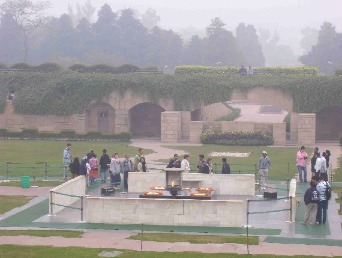
|
Birla
House where Mahatma Gandhi
was assassinated
on 30 January, 1948. The footsteps mark his final
path. |
Raj Ghat is a memorial to Gandhi and marks
the spot of his cremation on 31 January, 1948.
|
Old Delhi also introduced us to the Muslim
presence in India. About 13% of the population of India is
Muslim. The Muslims invaded India in three waves, the first around
1000 years ago. The last wave, called the Mughal Empire,
ruled northern India from 1526 until defeated by the British in
1858. We visited the site of the first Muslim minaret in
India, the Qutb Minar, built around 1100. It and the
surrounding building were built from the stones of destroyed Hindu
temples. We also visited the tomb of Humayun, the second
Mughal emperor (circa 1550). Later we visited the Red Fort
(so called since the outer walls are of red sandstone), built by
Shah Jahan, the same Mughal emperor who built the Taj Mahal (circa
1650). As you can see in the picture blow, Shah Jahan liked
to build beautiful structures with white marble. After the
fort we visited the surrounding Muslim quarter with its Mosque
(the third largest Mosque in the Muslim world). Since the Muslim
quarter was centuries old, its narrow twisty streets were best
viewed by rickshaw, and what a fun way to explore the area!
Varanasi
The holy city of Varanasi is the religious pilgrim destination for
Hindus. The city lies along the Ganges River, which is
considered a holy river by Hindus and worshiped as the goddess Ganga
in Hinduism. The city is located where the normally
east-west running river goes north-south. The entire city is built
on the west bank so that sunrise always illuminates the city.
The east bank is 100% agriculture, with no development of any type
visible from the city. The length of the city along the river
is lined with ghats – stairs that provide access to the
Ganges. It is along the ghats that there is so much to
see. Our tour arranged both a sunset boat ride and a sunrise
boat ride the next morning. What an experience.
Boat tourism is a major industry of Varanasi, for both pilgrims and
tourists. Our boat was one of dozens, not counting the hawker
boats that constantly came by. Oar power is used to move the
boats up and down stream so that we could observe the events along
the various ghats. The city is book-ended by cremation ghats,
one at either end of town. These go 24/7, and the ashes are
put into the river. For those without sufficient funds for
enough wood for a complete cremation, the remains are also put into
the Ganges. Between the two cremation ghats, a distance of
maybe a mile, are ceremonial ghats where we witnessed Hindu priests
putting the river to sleep at sunset and waking the river at
sunrise, washing ghats where laundry is done by beating it on stones
in the river and spreading it out on the stairs to dry, and bathing
ghats where people come to the river to purify
themselves.
The streets leading down to the river were chocked with traffic, and
as we got closer to the river, only pedestrian traffic. For our
sunset boat ride, the bus had to stop over a mile from the river, so
we rode rickshaws to about a block from the river. In the
morning, for our sunrise cruise, the bus was able to drive to within
a block of the river. Even with our short walks, cows of
course were everywhere, and avoiding the cow bombs was an added
challenge as we were walking at dusk.
Regrettably, bad weather caused our plane flight from Varanasi to
our next destination (Khajuraho) to be canceled. To help fill
the day we took a ride to Sarnath about five miles from Varanasi
(which took abut 1/2 hour due to traffic). Sarnath is where Buddha
preached his first sermon in 500 BC and is a pilgrim destination for
Buddhists. Buddha rejected Hinduism because of its links with
the caste system. Buddha kept many precepts of Hinduism, but
rejected the caste system and felt all people were equal.
Agra
The Taj Mahal is frequently referred to as
a monument to love as it was built by Mughal Emperor Shah Jahan as
the tomb for his wife Muntaz-i-Mahal (Jewel of the Palace, thus
Taj Mahal meaning Crown Palace). While it was customary for
emperors to have many wives, Shah Jahan had only three, and
apparently had a special relationship with Muntaz and spent little
time with the other two. Muntaz died giving birth to their
fourteenth child. The Taj was completed around 1653 after 22
years and 20,000 laborers and is considered to be one of the
world’s architectural masterpieces. We visited the white
marble edifice twice, mid-day and the following morning for
sunrise. While we had seen the standard pictures of the Taj,
what we were not prepared for were the grounds. The Taj is
the centerpiece of an enormous complex of gardens, fountains,
mosques, and gathering areas. There are three entrance gates
to the outer courtyard, a walled area with a covered arcade
running around the entire perimeter, perhaps 600 yards on a
side. We entered the outer courtyard from the west entrance
gate that was nearest our hotel. (There are also north and east
gates.) We walked through this courtyard to reach the main
gate, a large and imposing red sandstone structure which in and of
itself is an artistic gem. Our first glimpse of the Taj was
through the narrow hallway in the middle of the main gate.
There, on a pedestal of its own, set off by four minarets, with
only open sky as the backdrop, is the Taj. Its white marble
gleamed in the mid-day sun. It was truly beautiful.
And, as we walked through the Taj we saw the inlaid work of
precious and semi-precious stones, and carved screens all made
from white marble. The Mughal Emperor demanded perfection
and the craftsmanship lived up to his expectations. To this
day, the workmanship is incredibly beautiful.
On our first visit to the Taj there were thousands of visitors, and
they gave the Taj dimensions. The people appeared as ants
walking around on the pedestal and into the awesome domed
building. On our second visit, at sunrise, we were among the
first in, and without the people, the Taj lost its
dimensionality. Regrettably our sunrise visit was shrouded in
smog and the Taj lost its luster in the poor light. But on our
first visit, with the sun shining brightly, the intricate floral
patterns, the exquisite stone work and screens, were stunning.
The lower right hand picture is the Taj from our hotel room patio.
Jaipur
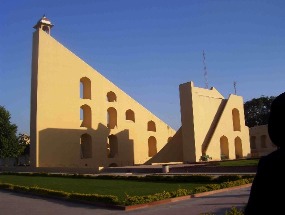 |
The Pink City is the nickname
for Jaipur. In 1853, when the Prince of Wales visited
Jaipur, the whole city was painted pink to welcome him, and
has remained pink ever since. The high point of our
town visit was to the Jantar Mantar, a collection of
astronomical instruments, built between 1727 and 1734, and
used for measuring time, predicting eclipses, tracking stars
in their orbits, and ascertaining the location of
planets. The instruments are very large and very
accurate. The sun dial at left is 20 feet high
and accurate to within 15 seconds of time. |
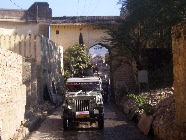
|
We visited the Amber Palace,
built high in the mountains overlooking the city. On
the way we had to wait for an elephant to cross the
road. It seems so funny to have horse drawn wagons,
elephants, cows and camel trains compete with our bus and
all the cars, rickshaws and motorbikes for the same road
space. The Amber Palace was built 400 years ago, and for
fortification they built a wall like the Great Wall of
China, only shorter. This one goes 10 miles around the
mountain. The wall is 20 feet high and wide enough for
4 horses. Incredible. Oh, and we had an Indiana
Jones jeep ride experience to get to the Palace, through
dusty narrow lanes, some with awesome views. In the
pre-jeep days, elephants were used to make the trek from the
bottom of the mountain to the palace. |
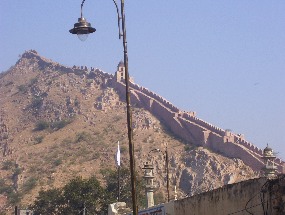 |
Udapuir
Udapuir is built around a lake and is famous for its floating
palace, built in 1743 of white marble as a summer palace.
Regrettably with the drought conditions the lake was very low and we
never sensed the palace as "floating." The palace is now
a hotel. We toured the City Palace and visited a Hindu temple,
and had a couple afternoons to shop or relax (we chose to walk the
grounds of our hotel, which were spectacular and described in the
hotel section below).
Cochin
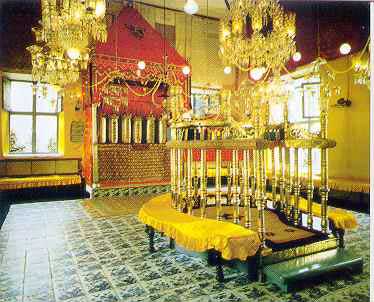 |
Cochin is toward the southern
tip of India, a port on the Arabian Sea. It has been a
major trading port for over 2000 years. We visited Jew
Town and its synagogue. Apparently the first Jews
arrived in Cochin 2000 years ago (after the destruction of
the Second Temple in Jerusalem). At one point, they
estimate 10,000 Jews lived in India. We visited the
Synagogue that was built in 1538 next to the local
Maharaja’s palace so that he could protect the Jews from the
Portuguese – they brought the inquisition with them to
India. We wandered around and found the Jewish
Cemetery but the gate was locked so could only see the
gravestones from a distance. There are 14 Jews left in
Cochin, all very old; all the young people moved to
Israel. When the last of the Cochin Jews die, the
Synagogue will be made into a museum. It was a
fascinating experience. It is interesting to note that
Cochin also has the first Christian church built in India,
Saint Francis. (Note: the picture at left was a
scan of a post card of the Synagogue as photographs were not
allowed inside.)
|
|
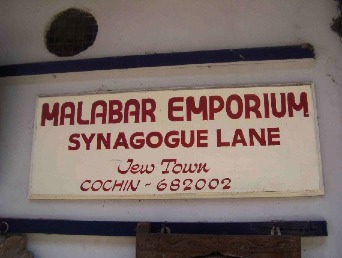 |
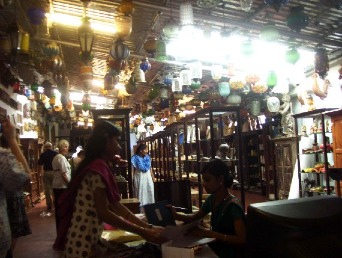 |
|
The southern area of India seemed very prosperous compared to the
horrific conditions we saw in the north. As we drove around
the area, it didn’t appear as poor and unkempt as so much of the
north had been. And we didn’t see the street people, the
fires, nor nearly as many animals. Our guide said that this
area was under communist rule for many years and that the level of
corruption was less than other parts of India so roads, housing,
schooling and other services got more attention, and thus our
observations were more or less correct.
Mumbai
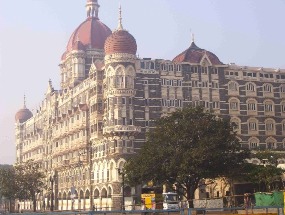 We
visited the Taj Mahal Palace Hotel which the November 2008
terrorists bombed and saw the memorial to the victims. Our
original tour itinerary had us staying at this hotel, but after the
attack our tour company changed the plans and had us skipping
Mumbai. But at the first meeting of the group in Delhi at the
beginning of the tour, the group we insisted that they rebook
Mumbai, which they did. They had us stay at a hotel outside
the city center. We saw the Taj Hotel about one month after
the attacks, and as you can see from our picture, the hotel looked
fully restored on the outside. We were told that they would be
re-opening the hotel soon.
We
visited the Taj Mahal Palace Hotel which the November 2008
terrorists bombed and saw the memorial to the victims. Our
original tour itinerary had us staying at this hotel, but after the
attack our tour company changed the plans and had us skipping
Mumbai. But at the first meeting of the group in Delhi at the
beginning of the tour, the group we insisted that they rebook
Mumbai, which they did. They had us stay at a hotel outside
the city center. We saw the Taj Hotel about one month after
the attacks, and as you can see from our picture, the hotel looked
fully restored on the outside. We were told that they would be
re-opening the hotel soon.
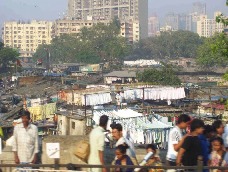
|
Our city
tour included driving through the slums of Mumbai,
unfortunately among the world's largest, and a stop at the
laundry ghat where the city's industrial laundry is done by
hand. Solar power is used to dry the thousands of
items each day. We also passed the massive water pipes
which bring water to the downtown area. But this
supply is insufficient for the population and so a water
delivery industry has evolved, with water trucks to deliver
water to roof top storage tanks. |
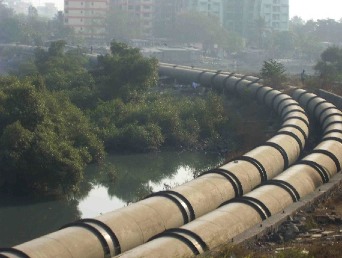
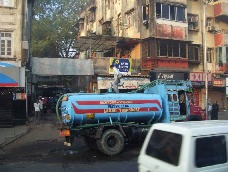
|
|
But the high point of our visit to Mumbai was our visit to the
Elephanta Caves, located on an island in Mumbai harbor. The
basalt rock-cut temple complex covers an area of 60,000 square feet
and was dug out over a four hundred year period (9th to 13th
centuries). The cave consist of chiseled out columns and
statues. Numerous 20 foot high statues of the Hindu god
Shiva in its many forms are represented, and all laid out so that
natural light and visual lines make them look striking. The
center piece is a three headed Shiva. Shiva is one of the main
Hindu gods. The picture
below was taken from the internet as our picture didn't come out in
the limited natural light. Tragically in the 17th century,
once again the Portuguese’s lack of tolerance for non-Catholic ideas
led them to deface or destroy much of the sculptor work. In
spite of this vandalism, the site was overwhelming in terms of man’s
ability to create incredible works of art.
Between the recurring themes and the incredible city sites, we had a
fantastic taste of India. But our hotels and the special
cultural events showed yet another perspective of this intriguing
country.
Photo journalist: Lois Frand
Writer:
Jason Frand
Editor:
Lois Frand
You can
reach us via email at Jason
or Lois
February 5, 2009






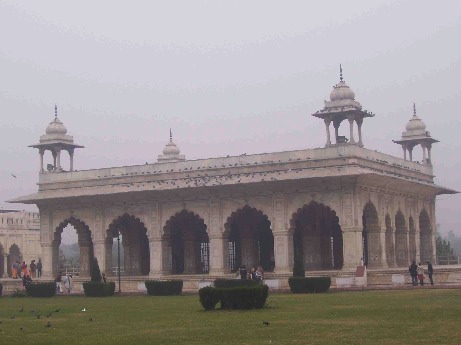
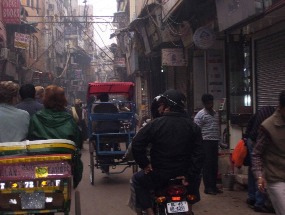
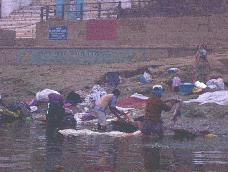

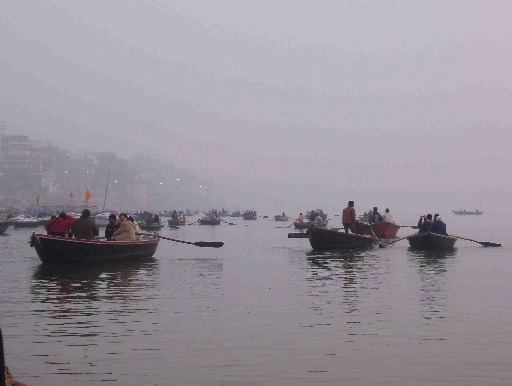
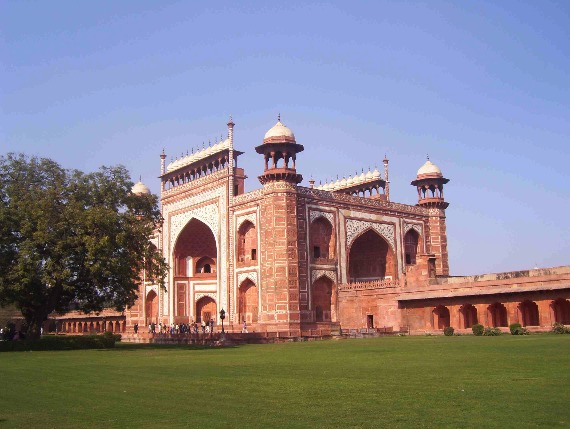
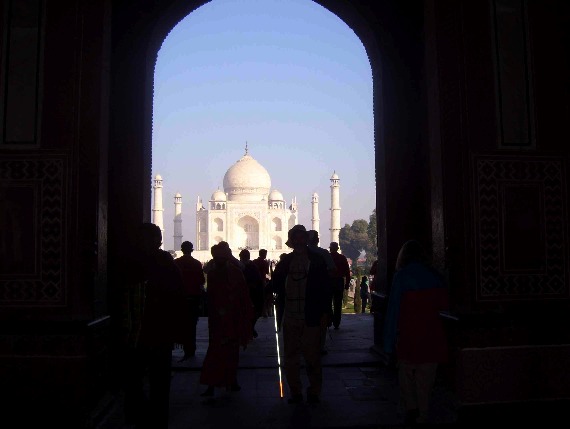


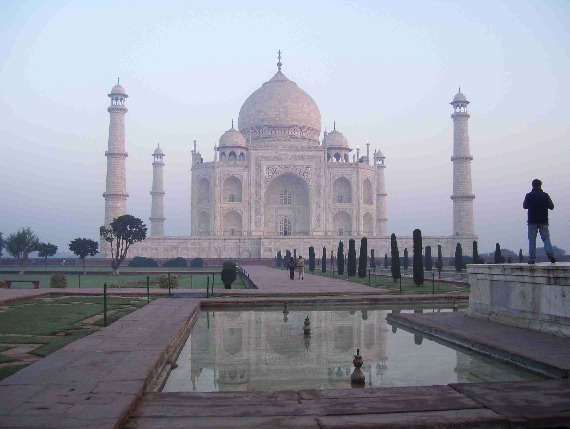




 We
visited the Taj Mahal Palace Hotel which the November 2008
terrorists bombed and saw the memorial to the victims. Our
original tour itinerary had us staying at this hotel, but after the
attack our tour company changed the plans and had us skipping
Mumbai. But at the first meeting of the group in Delhi at the
beginning of the tour, the group we insisted that they rebook
Mumbai, which they did. They had us stay at a hotel outside
the city center. We saw the Taj Hotel about one month after
the attacks, and as you can see from our picture, the hotel looked
fully restored on the outside. We were told that they would be
re-opening the hotel soon.
We
visited the Taj Mahal Palace Hotel which the November 2008
terrorists bombed and saw the memorial to the victims. Our
original tour itinerary had us staying at this hotel, but after the
attack our tour company changed the plans and had us skipping
Mumbai. But at the first meeting of the group in Delhi at the
beginning of the tour, the group we insisted that they rebook
Mumbai, which they did. They had us stay at a hotel outside
the city center. We saw the Taj Hotel about one month after
the attacks, and as you can see from our picture, the hotel looked
fully restored on the outside. We were told that they would be
re-opening the hotel soon.




